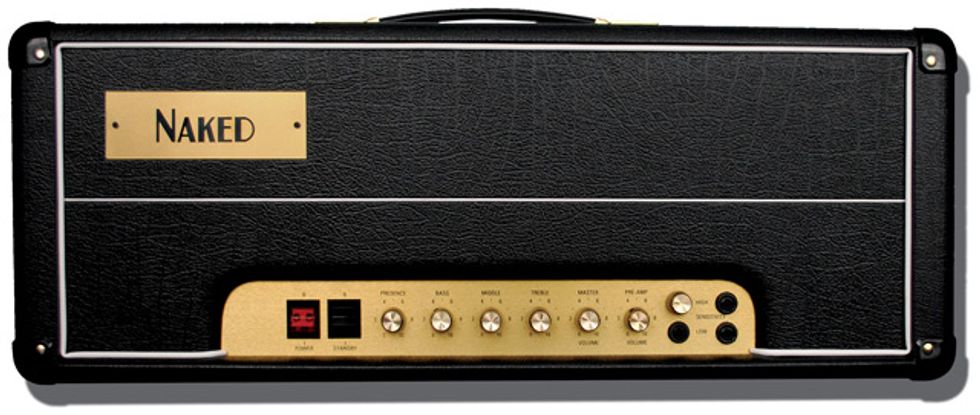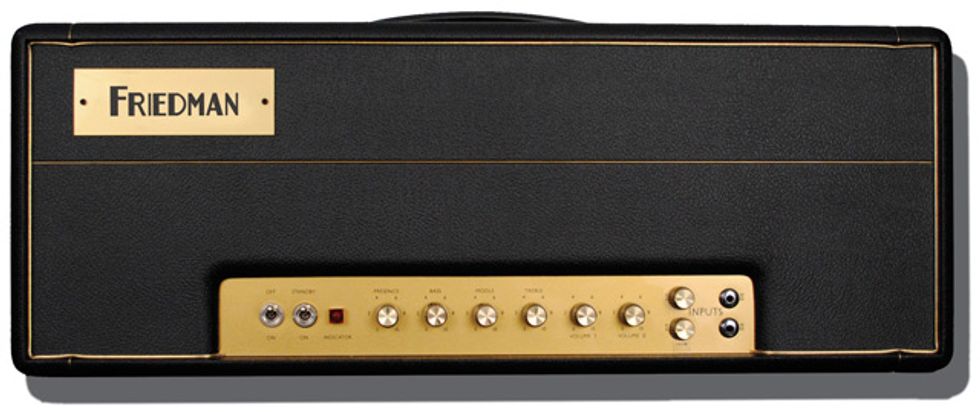For many guitarists, the name Dave Friedman
doesn’t have the cachet of, say, Eddie Van
Halen or Jerry Cantrell. Yet without Friedman’s
helping hand, Van Halen and Cantrell—as well
as a host of other guitar heroes—wouldn’t
sound as good as they do onstage or in the
studio. Through his company, Rack Systems,
Friedman has been building, modding, and
repairing gear for some of the world’s biggest
stars for the past 25 years. Rack Systems specializes
in high-grade, roadworthy switching
systems and large rackmount rigs. Friedman’s
innovative designs have made him legendary
in the world of professional touring musicians,
and the meticulous construction of his Rack
Systems gear has earned him a loyal clientele.
One of Friedman’s services is modifying amps,
and his extensive experience in this area has not
only helped him create great rigs for top players,
it has also led him to develop a brand-new
series of production amplifiers that are available
exclusively through Tone Merchants. This is a
first for Friedman, who is normally accustomed
to working with major acts on a one-on-one
basis. In the past, having Friedman build or mod
an amp for you required a level of notoriety, but
now his sonic wizardry is available to everyday
players in the form of two models.
The first, the Brown Eye, is a 100-watt high-gain
monster. The second, the Naked, is
actually a reissue of a highly sought-after
amp Friedman built 10 years ago for one of
rock’s premier guitarists. Recently, I got the
opportunity to dig into both of these heads,
and I can report that each is a stunning example
of electric guitar amplification.
Brown Eye
 | |
| Download Example 1 Clean | |
| Download Example 2 Hairy | |
| Download Example 3 Hairy with Saturation | |
| Download Example 4 With C45 engaged | |
| Clips recorded with a 1968 Reissue Gibson Les Paul Custom with Bare Knuckle pickups, mic'd with an SM57. | |
The Brown Eye’s front panel will be familiar to anyone who has played a Super Lead. The controls consist of a 3-band EQ (Treble, Middle, Bass), dual volume knobs (Volume I and Volume II), and a single Presence control. Like the venerable Marshall Super Lead, the amp sports four inputs. However, our review unit swaps two of these input jacks for a pair of knobs labeled Clean and Gain. Friedman calls this option the Simple Clean Channel mod, and it gives the Brown Eye two independent channels. Using these knobs, you can set clean and overdrive levels and then toggle between them with a footswitch. Volume I and Volume II function as independent master volumes in this scenario, which is really cool because it allows you to set two separate volume settings if you want to kick in a boost for a solo or bring the volume down with a simple foot stomp.
Each of the Brown Eye’s two inputs has its own voicing—but they’re not simply high- and lowgain versions of the same circuit, as you’d find on stock ’60s Marshalls. Friedman calls these inputs “Brown Eye” and, ahem, “Hairy Brown Eye.” Both are hotter than a vintage-style circuit, with Hairy offering the hottest signal.
Brown Sounds
Using a dual-button footswitch, I was able to easily move between a raging high-gain tone, a smooth-and-loud clean sound, and a volume-boosted iteration of the high gain channel. The Brown Eye’s clean tone blew my mind. If you’ve ever played through a healthy, late-’60s Marshall, you’ll know what I’m talking about, because there really is nothing else quite like that clean tone. Few of us are lucky enough to own a vintage Super Lead, so it’s exciting to know that these huge, biting sounds are available in a new amp. Being able to switch between high-gain and huge clean timbres is a real treat.
Compared to its companion, the Hairy input has a slight gain boost, yet when I plugged a 1978 Gibson Les Paul Custom into this input, I noticed more of a difference in feel than tone. The added saturation made it a little more difficult to coax dynamics out of the amp, but it was still possible to drastically change its response by rolling back the guitar’s volume knob.
As I mentioned, PG’s review unit arrived with all of Friedman’s available modifications. Other than the Clean and Gain knobs that constitute the Simple Clean Channel mod, these extras are accessed on the back panel.
First in line is a Fat switch, which thickens up the low end to help fill out rhythm parts. I liked this because it didn’t increase the gain at all. Engaging the Fat switch livened up the tone from a Tele without adding grit to its spanky sound. This simply helped the Tele project better across the room.
Adjacent to the Fat switch is another switch that controls Friedman’s Custom 45 response mod. Flipping this switch smoothed out the tone a bit more, while adding a bit of chime and openness to the highs.
When I was ready to hear what sorts of gain this monster could muster, the next control, Sat (saturation boost), helped me do so—in spades. Throwing the Sat switch, I immediately understood why Steve Stevens and Jerry Cantrell are using the Brown Eye in their rigs. The pure, raw aggression lunging from the amp was staggering, to say the least. Low notes were super tight and punchy, and the highs carried a really nice sting.
As far as midrange voicing, I think you’d be hard-pressed to best the Brown Eye’s overdrive.
With all the versatility and power it offers, what really sets it apart is its Presence control. The knob doesn’t simply boost highs and add shimmer, it adds more girth, dimension, gain, and perceptible volume. Taming the Brown Eye’s high-gain settings only required lowering the Presence knob, which softened the high-end response and eased off the screaming gain a bit. It’s as if you have a retractable muzzle, with the higher settings pulling back the mask to let the razor-sharp mids and highs bite through. With the gain channel, Friedman reveals his intense love of vintage-Marshall-flavored overdrive, but what about those lovely old plexi cleans? I was really curious about this, because my favorite clean tones have come from sweet vintage Marshalls. I’m happy to report that the Brown Eye nails the distinctive, percussive tones that plexi amps are known for.
Thanks to the Simple Clean Channel mod, I could adjust the preamp gain in tandem with the master volume. There’s nothing in the world like standing in front of an old plexi set clean, and forcefully hitting a bunch of chords in succession. The sound hits you in the chest in a way that no other amp can duplicate, but the Brown Eye gets really, really close. Armed with my Les Paul, I got wicked midrange punch and a solid low end, but with a slightly hi-fi edge to the upper frequencies. The detailed highs were especially noticeable with a Telecaster. I wouldn’t say it was a sonic detriment, but rather an unexpected result. The slightly modern edge of the amp’s clean sound might turn off some players who like bouncier, spongier tones. That said, the Brown Eye’s spectacular clean voice—which has massive amounts of headroom—is muscular and rings evenly throughout the guitar’s range.
The Final Mojo
With the Brown Eye, Dave Friedman has packed decades of circuit design and modification know-how into a head that represents the finest Marshall-inspired tones he can muster. Players who gravitate toward amps with a strong upper-midrange spike and immediate attack should really take a look at the Brown Eye. If you love the pure aggression of a healthy, late-’60s plexi, yet demand modern features like channel switching, the Brown Eye is extremely hard to beat.
Buy if...
you want one of the finest representations of classic and modern British high-gain tones available.
Skip if...
you want a traditional American sound.
Rating...
Street $3000 100-watt head; $2800 50-watt head; options from $50-$500 - Rack Systems - tonemerchants.com |

Naked
 | |
| Download Example 1 Clean | |
| Download Example 2 Dirty 1 | |
| Download Example 3 Dirty 2 | |
| All clips were recorded with a Bogner 2x12 20th Anniversary cabinet with Celestion G12H30s, an SM57 into a Digidesign Elevenrack with Pro Tools 8.0.3. Guitar was a 1978 Gibson Les Paul Custom with Tom Anderson pickups. | |
I can clearly recall the first time I heard A Perfect Circle’s self-titled album—I was amazed by how unique the guitar tones were. The mushy sound of typical radio-rock grind was replaced with a crisp, robust wall of sound that had dimension and texture. When I asked Friedman why he waited a decade to release this amp as a production model, he said “Today, it’s easier to promote amps like the Naked because of the Internet. Ten years ago, the market was different, and it was a lot harder to get the word out about something like this. But now, the rules have changed. So, why not?”
Feature Talk
The new Naked is based on the circuitry of the first Naked amps, and it offers many of the same functions. You can switch between two channels, clean and overdrive, using a single-button footswitch that plugs into one of the front jacks. Both channels share a simple 3-band EQ with a highly sensitive Presence control. The Naked’s minimal features are rounded out with an effects loop that’s wired in series.
Aesthetically, the amplifier is an homage to the Marshall Super Lead models of the late ’70s, with large rocker switches for Power and Standby, and white piping instead of gold. Howerdel’s Friedman-modded ’78 Marshall JMP was not only the tonal basis for the Naked, but obviously had a major impact on its visual accoutrements, as well.
After I had a chance to set up the amp and take a test run with my trusty Les Paul, I felt really comfortable gazing at the familiar front panel. I’ve played a lot of Marshalls, so I felt like I’d ridden this bike before and there was no fear of falling off. The era-correct metal panel sports four inputs, with the upper-left one taken up by the Clean channel’s preamp gain control.
I was intrigued to see how Friedman paid tribute to the original, modded late-’70s Marshall by the way he wired the Naked’s input jacks. The bottom-left input is wired for the previously mentioned footswitch, and the upper right input is for the guitar. Friedman could have easily installed a jack on the rear panel for the footswitch and used a faceplate with only a single input drilled into it, but he chose to have the amp’s aesthetics reflect all the modding he has done over the years. It’s familiar and functional, and keeps a visual continuity with his custom work. Unlike the Brown Eye, the Naked is stripped bare of extra frills other than the effects loop. There are no additional mods or enhancements—what you hear is what you get.
Plugging In
Despite their similar looks and British highgain influences, the Brown Eye and the Naked have very different tonal qualities. With its rear-panel voicing switches, the Brown Eye obviously has the upper hand in terms of versatility. But this doesn’t mean the Naked isn’t capable of producing malleable, robust sounds. What it really comes down to is what kind of player is using the amp.
Earlier, I mentioned that the Brown Eye should appeal to players who like a more immediate attack and extraordinary detail in the upper mids. Those frequencies really start to show themselves in a stronger light when the guitar is in standard tuning or perhaps a half-step below. With the Naked, though, it’s all about dropped tunings. This was of special interest to me, as I like to keep one of my guitars tuned down to C#. I can’t tell you how many Marshall (and Marshall-esque) amps I’ve gone through over the years that just can’t keep the signal tight and focused when I’m tuned down that low.
With the Naked and its custom-voiced circuit, that frustrating issue was nowhere to be found. The jumbled, fuzzy mess of distorted, down-tuned riffs was substituted with quite possibly the tightest, meanest British overdrive I’ve ever experienced. Every lowstring palm mute coming out of my 20th Anniversary Bogner 2x12 cabinet was crisp and clear, with that perfect sag in the mids that Marshall lovers obsess over. I’ve played (and owned) some fantastic British-voiced amps throughout the years, but nothing was ever quite this good in terms of high gain.
My 1978 Gibson Les Paul Custom, which has a Bare Knuckle Warpig in the bridge position, sang up and down the fretboard, delivering biting, detailed tones and some of the best note definition I’ve ever come across. It was almost as if there were two voicings in the frequency spectrum—one being a darker, more aggressive tone in the low end, and the other being sweet, bright, and soft in the upper registers.
And, just like the Brown Eye, the Presence control has a massive overall effect on the sound. The control really starts to kick in between the 1 o’clock and 5 o’clock positions, considerably boosting both the gain and upper-end frequencies in the higher settings. It’s almost a voicing control at this point, because slight changes pull it from hard rock to raging Slayer territory. It’s flatout amazing just how well the Presence control changes the tone, and it was definitely the secret weapon in my amp testing. During these tests, I found no need to change the EQ from where I had originally set it, because there was a myriad of spectacular, completely usable tones to sweep through, thanks to that single knob.
Even after experiencing the Naked’s extraordinary overdrive tones, I could not ignore its great clean channel. The dark-toned nature of the Naked really shows itself here, and it hearkens back to the clean sounds of late- ’70s Marshalls. Generally, most Super Leads from the early ’70s and late ’60s are considered to have a brighter sound than those released much later. The smooth, clean tone on the Naked was more in line with its late- ’70s Marshall forebears, and it offers more of a traditional response than the Brown Eye.
The Naked has a huge amount of available headroom, and, used in tandem with the master volume, the two preamp controls let you sculpt the top end. Higher preamp settings rolled off those upper frequencies but caused slight distortion when I struck the strings harder. The Naked’s touch sensitivity came into play very nicely here, and footswitching between the two channels put even more timbral options at my fingertips.
The Final Mojo
As any gear fanatic will tell you, the more you explore a particular sonic area, the better you’re able to scrutinize and pick apart aspects and traits of your equipment. In this case, my personal love of great Marshall tone was almost a hindrance. The Naked was specifically designed for a taste that’s very similar to my own, which makes it hard to find areas to critique. If I got a harsh, unpleasant tone, it was easy to dial it out with either a slight turn of the Presence control or by simply backing off the gain. The Naked is designed to perform exactly this way, and it succeeds admirably. If you love British high-gain sound, you’ll be right at home with the Naked. And if you’re looking for an amp that can deliver tight and focused tones with lowered tunings, you must experience Friedman’s Naked amp.
Buy if...
you want the smooth, dark overdrive of a late-’70s Marshall with enhanced gain for modern rock riffing.
Skip if...
lower gain, Fenderish tones are more your taste.
Rating...
Street $3500 100-watt head; $3300 50-watt head - Rack Systems - tonemerchants.com |








![Rig Rundown: Russian Circles’ Mike Sullivan [2025]](https://www.premierguitar.com/media-library/youtube.jpg?id=62303631&width=1245&height=700&quality=70&coordinates=0%2C0%2C0%2C0)


























